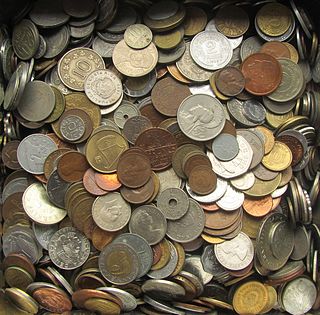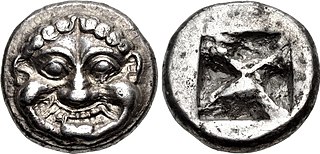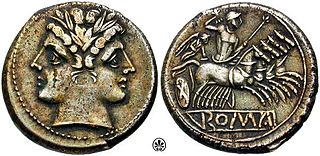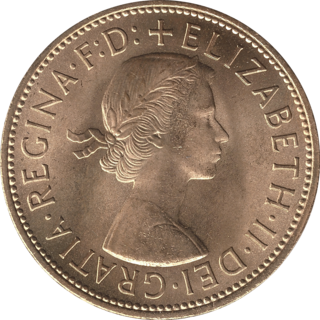The bes (pl.: besses) was an Ancient Roman bronze coin produced during the Roman Republic. Valued at two thirds of an as (eight unciae), [1] it was only produced in 126 BC by C. Cassius in combination with the dodrans, [2] another very rare denomination which was valued at three quarters of an as (nine unciae). The obverse head displayed the god Liber facing to the right. [1]

Coin collecting is the collecting of coins or other forms of minted legal tender. Coins of interest to collectors include beautiful, rare, and historically significant pieces. Collectors may be interested, for example, in complete sets of a particular design or denomination, coins that were in circulation for only a brief time, or coins with errors. Coin collecting can be differentiated from numismatics, in that the latter is the systematic study of currency as a whole, though the two disciplines are closely interlinked.

A coin is a small object, usually round and flat, used primarily as a medium of exchange or legal tender. They are standardized in weight, and produced in large quantities at a mint in order to facilitate trade. They are most often issued by a government. Coins often have images, numerals, or text on them. The faces of coins or medals are sometimes called the obverse and the reverse, referring to the front and back sides, respectively. The obverse of a coin is commonly called heads, because it often depicts the head of a prominent person, and the reverse is known as tails.

The history of ancient Greek coinage can be divided into four periods: the Archaic, the Classical, the Hellenistic and the Roman. The Archaic period extends from the introduction of coinage to the Greek world during the 7th century BC until the Persian Wars in about 480 BC. The Classical period then began, and lasted until the conquests of Alexander the Great in about 330 BC, which began the Hellenistic period, extending until the Roman absorption of the Greek world in the 1st century BC. The Greek cities continued to produce their own coins for several more centuries under Roman rule. The coins produced during this period are called Roman provincial coins or Greek Imperial Coins.

The quadrigatus was a medium-sized silver coin produced by the Roman Republic during the 3rd century BC. The obverse featured a young janiform bust and the reverse featured Victory driving a quadriga, giving the coin its Roman name, with the inscription "ROMA" below.

The semis was a small Roman bronze coin that was valued at half an as. During the Roman Republic, the semis was distinguished by an 'S' or 6 dots. Some of the coins featured a bust of Saturn on the obverse, and the prow of a ship on the reverse.

The siliqua is the modern name—given without any ancient evidence to confirm the designation—to small, thin, Roman silver coins produced in the 4th century and later. When the coins were in circulation, the Latin word siliqua was a unit of weight or value defined by one late Roman writer as one twenty-fourth of a Roman solidus.
"Siliqua vicesima quarta pars solidi est, ab arbore, cuius semen est, vocabulum tenens."
A siliqua is one twenty-fourth of a solidus, having its name from the tree of which it is the seed.

The quadrans or teruncius was a low-value Roman bronze coin worth one quarter of an as. The quadrans was issued from the beginning of cast bronze coins during the Roman Republic, showing three pellets representing three unciae as a mark of value. The obverse type, after some early variations, featured the bust of Hercules, while the reverse featured the prow of a galley. Coins with the same value were issued from other cities in Central Italy, using a cast process.

The triens was an Ancient Roman bronze coin produced during the Roman Republic valued at one-third of an as. The most common design for the triens featured the bust of Minerva and four pellets on the obverse and the prow of a galley on the reverse. It was not a common denomination and was last struck c. 89 BC.
Roman Republican currency is the coinage struck by the various magistrates of the Roman Republic, to be used as legal tender. In modern times, the abbreviation RRC, "Roman Republican Coinage" originally the name of a reference work on the topic by Michael H. Crawford, has come to be used as an identifying tag for coins assigned a number in that work, such as RRC 367.
The Attic talent, also known as the Athenian talent or Greek talent, is an ancient unit of weight equal to about 26 kilograms (57 lb), as well as a unit of value equal to this amount of pure silver. A talent was originally intended to be the mass of water required to fill an amphora, about one cubic foot (28 L).
Roman provincial currency was coinage minted within the Roman Empire by local civic rather than imperial authorities. These coins were often continuations of the original currencies that existed prior to the arrival of the Romans. Because so many of them were minted in the Greek areas of the empire, they were usually referred to until fairly recently as Greek imperial coinage, and catalogued at the end of lists of coins minted by the Greek cities.
This glossary of numismatics is a list of definitions of terms and concepts relevant to numismatics and coin collecting, as well as sub-fields and related disciplines, with concise explanations for the beginner or professional.

The coinage of the Seleucid Empire is based on the coins of Alexander the Great, which in turn were based on Athenian coinage of the Attic weight. Many mints and different issues are defined, with mainly base and silver coinage being in abundance. A large concentration of mints existed in the Seleucid Syria, as the Mediterranean parts of the empire were more reliant on coinage in economic function.
The dodrans or nonuncium was an Ancient Roman bronze coin produced during the Roman Republic.
Aes grave is a term in numismatics indicating bronze cast coins used in central Italy during the 3rd century BC, whose value was generally indicated by signs: I for the as, S for semis and pellets for unciae. Standard weights for the as were 272, 327, or 341 grams, depending upon the issuing authority.

Like the Egyptians, Phoenicians and Carthaginians, the Etruscans were rather slow to adopt the invention of coinage. The brief period of Etruscan coinage, with the predominance of marks of value, seems to be an amalgam that reconciles two very different monetary systems: the 'primitive' bronze-weighing and aes grave economy of central Italy with that of struck silver and gold issues of southern Italian Greek type not familiar in Etruria.

Bar Kokhba revolt coinage were coins issued by the Judaean rebel state, headed by Simon Bar Kokhba, during the Bar Kokhba revolt against the Roman Empire of 132–135 CE.

The British pre-decimal penny was a denomination of sterling coinage worth 1⁄240 of one pound or 1⁄12 of one shilling. Its symbol was d, from the Roman denarius. It was a continuation of the earlier English penny, and in Scotland it had the same monetary value as one pre-1707 Scottish shilling. The penny was originally minted in silver, but from the late 18th century it was minted in copper, and then after 1860 in bronze.

Barclay Vincent Head was a British numismatist and keeper of the Department of Coins and Medals at the British Museum.

The coinage of Capua concerns coins minted in ancient Capua, a city in ancient Campania, corresponding to present-day Santa Maria Capua Vetere. The city was located on the Appian Way and was the most important in the area, probably the largest center in the Italian peninsula after Rome.